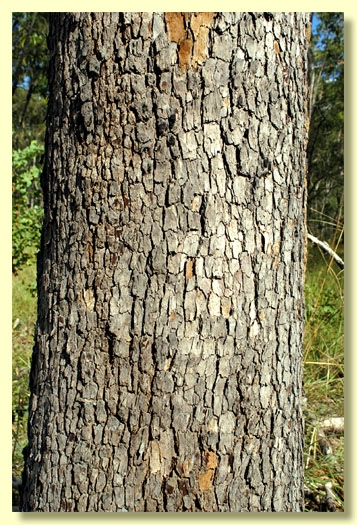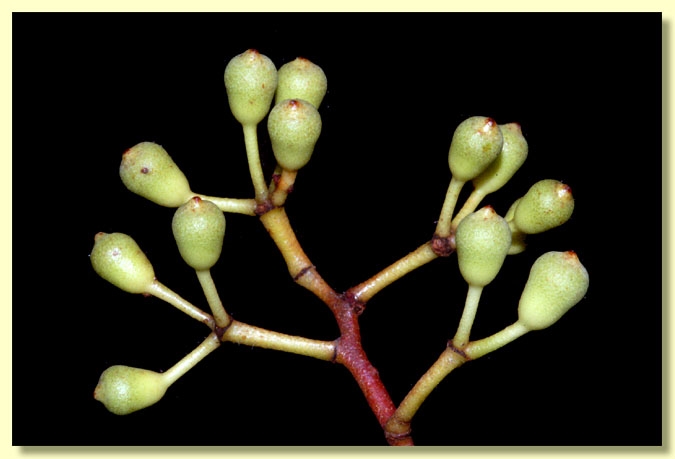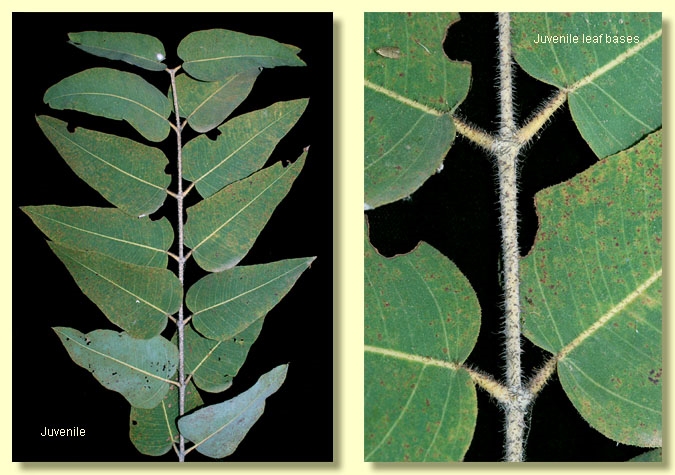Corymbia | Rufaria
Euclid - Online edition
Corymbia nesophila
Tree to30 m tall. Forming a lignotuber.
Bark rough to small branches, grey to grey-brown, tessellated to crumbly.
Branchlets lack oil glands in the pith; smooth.
Juvenile growth (coppice or field seedlings to 50 cm): stems rounded in cross-section, setose with bristle-glands for at least the lower ca 8 nodes; juvenile leaves always petiolate, opposite for many nodes, or some pairs sub-opposite, predominantly cordate to ovate but may be ± lanceolate to elliptical, 4.8–12.5(23) cm long, 2.3–8 cm wide, base lobed to rounded but often a few leaves peltate, apex of lowest leaves emarginate, then rounded and apiculate or broadly pointed further up the stem, dull, green, discolorous; leaves have sparsely distributed bristle-glands and numerous short white simple hairs on both sides. Bristle-glands are also ornamented with short simple hairs.
Adult leaves predominantly alternate but sometimes a few pairs sub-opposite, petioles 0.9–2.3 cm long; blade lanceolate to falcate, 7.3–21 cm long, 0.7–2.8 cm wide, base tapering to petiole, margin entire, apex pointed, slightly discolorous, glossy or only slightly so, green, smooth, side-veins at greater than 45° to midrib, reticulation dense to very dense, intramarginal vein visible but close to margin, oil glands usually present, island and intersectional, one per areole.
Inflorescence terminal compound, peduncles relatively slender, 0.5–1.7 cm long, buds 7 per umbel, pedicels 0.3–1.1 cm long. Mature buds obovoid to pyriform, 0.5–0.7 cm long, 0.3–0.5 cm wide, smooth, scar absent (both opercula shed together at flowering), operculum very shallowly rounded and apiculate to shallowly and bluntly conical, stamens inflexed, all fertile, anthers oblong, dorsifixed, versatile, dehiscing by longitudinal slits, style usually long (rarely not reaching the underside of the operculum), straight, stigma blunt and long-papillose, locules 3(4), the placentae each with ca 5 ± distinct ovule rows. Flowers creamy white.
Fruit pedicellate (pedicels 0.4–0.9 cm long), thin-walled, urceolate with a neck not or scarcely flared at the rim, if neck short then fruit ± barrel-shaped, 0.8–1.5 cm long, 0.6–1 cm wide, longer than wide, smooth, disc descending vertically, valves 3(4), enclosed.
Seeds brown, 6–7 mm long, ellipsoidal with terminal wing, hilum ventral.
Cultivated seedlings (measured at ca node 10): cotyledons reniform; stems rounded in cross-section, setose with bristle-glands; leaves shortly petiolate, opposite for at least 8–10 nodes, narrowly elliptical to oblong or lanceolate but becoming broader up the stem, 6–10 cm long, 1–3 cm wide, base tapering to rounded on lower leaves, peltate or lobed after ca node 10, dull, green, discolorous, sparsely setose with bristle-glands and short white simple hairs on both surfaces.
Flowering has been recorded in May, June, July and August.
A common bloodwood tree of disjunct distribution in monsoonal northern Australia, from the northern Kimberley region of Western Australia, e.g. Bonaparte Archipelago, Mitchell Plateau, Bougainville Peninsula, where it is found on laterite or basalt sites; the Top End of the Northern Territory, where it is restricted to Cobourg Peninsula, Maningrida, and Bathurst and Melville Islands, where it is found on lower slopes and flats of sands or sandy-loams; in Queensland on Cape York Peninsula, where it is widespread from Cooktown north to Bamaga on laterite sites; and in Torres Strait on Thursday Island and Horn Island. Corymbia nesophila has extensive grey tessellated to crumbly rough bark, adult leaves that are green but paler on the underside, small smooth buds and urn-shaped to barrel-shaped fruit to 1.5 cm long and 0.6–1 cm wide. Juvenile leaves are moderately large, usually ovate to cordate, and sparsely setose with bristle-glands.
The widespread C. polycarpa differs from C. nesophila in having very scurfy buds and fruit narrowly barrel-shaped and always much longer than wide. C. intermedia differs from C. nesophila in having larger ovoid to barrel-shaped fruit 1–1.6 cm wide and juvenile leaves only slightly scabrid.
C. nesophila is distinguished from other rough-barked bloodwoods in the Queensland and Torres Strait monsoonal zone by its dull green juvenile leaves, which are predominantly ovate to cordate and 2.3–8 cm wide. C. stockeri (both subspecies) and C. hylandii have much narrower juvenile leaves that are glossy green on the upper surface, but have similar fruit. C. novoguinensis differs in having very scurfy buds and fruit 1.1–1.5 cm wide.
In the far north of the Northern Territory other rough-barked bloodwoods with alternate discolorous adult leaves are: C. porrecta, which differs from C. nesophila in having much larger, ovate, glabrous juvenile leaves 11–17 cm wide and larger thick-walled urn-shaped fruit 1.5–2.6 cm wide; and C. arnhemensis, which has elliptic-lanceolate juvenile leaves only 2–4 cm wide and sparsely setose, rough bark extending only over the trunk rarely to the larger branches, but small fruit very similar to C. nesophila.
In the far north of the Kimberley region of Western Australia, C. nesophila is only likely to be confused with C. arenaria, a species with very thick chunky rough bark throughout rather than being platy and tessellated, usually glabrous, shortly petiolate, lanceolate juvenile leaves 1.8–4 cm wide, and small fruit of similar size to those of C. nesophila but more squat in appearance. C. polycarpa also occurs here and its differences are outlined above. All other fully rough-barked Kimberley bloodwoods have larger fruit.
MORE ABOUT CORYMBIA
MORE ABOUT RED BLOODWOODS
Corymbia nesophila: Greek nesos, island, and philos loving, referring to its (often) island occurrence.













